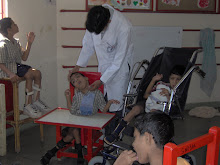'The difference between what we do and what we are capable of doing would suffice to solve most of the world's problems.'
Mahatma Gandhi
One of the greatest challenge for any program that reaches out to those with special needs is the issue of funding. No decent human being ( and i do believe that all of us are inherently decent) would ever in principle refuse to care for an individual with special health care needs, however the question that everyone raises is, who will pay for it? Be it private practitioners for whom treatment is about making enough to keep their practice afloat, or government aided programs, whose aim is to keep the program afloat, the question is always about funding.
This raises the rather obvious question, how much money do we need, and is the issue really one of money. The traditional socialist response to this problem would be that if each-one contributed a certain amount of time from their schedules to treat individuals with special needs then the issue would no longer be one of money. If each dentist treated say, one individual with special needs for every ten patients then there would be no shortage of doctors that individuals with special health care needs could turn to. Problem solved? Not quite.
Unfortunately treatment of individuals with special needs needs training, and in the traditional socialist model, this training would have to provided by institution, departments, centralized centers of learning. And that raises our all too familiar question... Who will pay for it?

Alternatively people who believe that the market is supreme would argue that if there was really no one providing care for individuals with special care needs, then then treating such individuals would definitely make economic sense and more practitioners would be drawn towards the treatment of individuals with special care needs. However anyone with any experience practicing special needs dentistry would point out that treating individuals with special needs requires not only more experience, training and often materials, but also time. And in private practice, where time is money... Who will pay for it?

While this type of circular logic can get frustratingly bogged in a debate about the merits of economic system or policy, the purpose of this article is far from that. I merely wish to point out that today technology allows people on the ground, regardless of what type of health care system their country follows, to actually implement dental care to individuals with special needs without increasing the cost, to either state or practice. DCSN looks at how the internet, and interactive learning could help overcome the age old barrier of cost.
Widening the Base
One of the biggest advantages of a connected world is that today someone who wishes to learn a new technique can simply go online and learn. One of the most impressive sites i have come across in this realm is a site called DINOH http://www.dinoh.org/. The site puts up information, videos and techniques by which dentists can improve their skills with individuals with special needs. An online database greatly reduces the cost of education. And if a dentist in a far corner of the world can learn the latest techniques at virtually no cost, then she transfers not only her new found skill, but also the cost benefit to the patient.
Categorizing Treatment
One of the greatest challenges that affects both dentists and parents, is the fear of the unknown. Very often simple care, especially preventive care, can be provided by any dentist or dental hygienist. However the fear of the parent/patient, combined with the fear of the dentist mean that the child is referred to a specialist, for treatment that could have well been provided faster and cheaper. The traditional logic has been that it is better to prevent a serious complication by the dentist than risk a complication. While this argument does have its merit, it can also be argued that in today's interconnected world, we should be looking at using connectivity to help both parents and dentists determine which procedures carry risks and where the risk is negligible.
Reinventing Teledentistry
When the digital revolution swept the world, in the early 1990s there was a lot of literature on using this new tool called the internet, to spread medical care. Telemedicine became a reality in many parts of the world. In the late 1990s there were a few articles on teledentistry. However in an era of dial-up modems and excruciatingly slow internet, not to mention sky high phone bills; many assumed that it was just not feasible. The world has come a long way in the past decade. Today, high speed internet is not only a reality in many developing countries, it is also cheap. A country like India, has not only one of the most extensive internet networks in the world, but also the cheapest. In this new world order, past objections to teledentistry fall flat. A network that reaches out to dentists and parents alike, can greatly reduce problems of access for the parent, improve connectivity and communication among dentists and go a long way in widening the base of people able to provide care for individuals with special health care needs.
The attack of the killer 'apps'
I recently asked a student who was about to extract a tooth in a child with a congenital heart disease what antibiotic prophylaxis she would consider. I got the shock of my life when she pulled out her 'smartphone' and started reading the prophylaxis. I couldn't make up my mind whether I was angry because she did not know it, or amazed that she felt she did not not need to know it because she had an "app" for it! While I in no way endorse ignorance or any phone or product, I had to think, do these "apps" have a role in promoting special needs dentistry?
While an app to educate parents, or apps that help dentists diagnose and treat patients may sound far fetched, a well designed app could go a long way in doing just that.
Decentralization
While only time will tell if the advantages of connectivity outweigh potential risks, one thing interactive learning will definitely accomplish is decentralization. Interactive learning offers far greater flexibility to local dentists to determine which of the models of learning they find online would be best suit their patients. Instead of relying on governments or institutions to solve problems (thus fund those solutions), the dentists could use the resources available online to apply whichever model best suited their patients. The virtually free cost of the solution would enable dentists to provide the treatment at no added cost to the patient. Such a model would still require strong online databases, which in turn would require academic institutions focussed on developing such a database.
The examples mentioned above illustrate how the interactive learning can greatly reduce the cost of providing dental care to individuals with special needs. The internet, or technology cannot replace the dentist. The delivery of quality dental care to individuals with special care needs will still require committed dentists and institutions that can provide resources to those dentists. All the internet does, is it makes the dissemination of those resources a litter easier and a whole lot cheaper.









